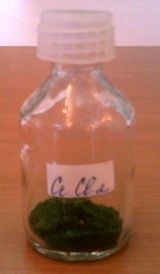Formula CrCl2 Density 2.9 g/cm³ Boiling point 1,120 °C | Molar mass 122.902 g/mol Melting point 824 °C | |
 | ||
Appearance White to grey/green powder (anhydrous), very hygroscopic | ||
Chromium(II) chloride describes inorganic compounds with the formula CrCl2(H2O)n. The anhydrous solid is white when pure, however commercial samples are often grey or green; it is hygroscopic and readily dissolves in water to give bright blue air-sensitive solutions of the tetrahydrate Cr(H2O)4Cl2. Chromium(II) chloride has no commercial uses but is used on a laboratory-scale for the synthesis of other chromium complexes.
Contents
Synthesis
CrCl2 is produced by reducing chromium(III) chloride either with hydrogen at 500 °C:
2 CrCl3 + H2 → 2 CrCl2 + 2 HClor by electrolysis.
Small scale preparations can use LiAlH4, Zinc or related reagents, to reduce CrCl3
4 CrCl3 + LiAlH4 → 4 CrCl2 + LiCl + AlCl3 + 2 H22 CrCl3 + Zn → 2 CrCl2 + ZnCl2CrCl2 can also be prepared by treating a solution of chromium(II) acetate with hydrogen chloride.
Cr2(OAc)4 + 4 HCl → 2 CrCl2 + 4 AcOHStructure and properties
Anhydrous CrCl2 is white however commercial samples are often grey or green. It crystallizes in the Pnnm space group, which is an orthorhombically distorted variant of the rutile structure; making it isostructural to calcium chloride. The Cr centres are octahedral, being distorted by the Jahn-Teller Effect.
The hydrated derivative, CrCl2(H2O)4, forms monoclinic crystals with the P21/c space group. The molecular geometry is approximately square planar with Cr—O distances of 2.078 Å and two Cr—Cl distances of 2.758 Å.
Reactions
The reduction potential for Cr3+ + e− ⇄ Cr2+ is −0.41. Since the reduction potential of H+ to H2 in acidic conditions is +0.00, the chromous ions has sufficient potential to reduce acids to hydrogen, although this reaction does not occur without a catalyst.
Organic chemistry
Chromium(II) chloride is used as precursor to other inorganic and organometallic chromium complexes. Alkyl halides and nitroaromatics are reduced by CrCl2. The moderate electronegativity of chromium and the range of substrates that CrCl2 can accommodate make organochromium reagents very synthetically versatile. It is a reagent in the Nozaki-Hiyama-Kishi reaction, a useful method for preparing medium-size rings. It is also used in the Takai olefination to form vinyl iodides from aldehydes in the presence of iodoform.
